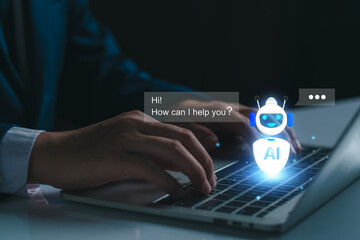We always say, “Content is King,” but now this kingdom has two writers: one Human and the other AI.
AI is changing how we make and use information as it gets better. But can AI really match the imagination and depth of writing done by people? This change in technology isn’t just changing how information is made; it’s also changing how people interact with and understand material.
Everyone’s main concern is whether artificial intelligence—which excels in data analysis and natural language understanding—can truly challenge human writers in terms of creativity, emotional depth, and narrative-telling complexity. This case study of the pros, drawbacks, and probable futures of both artificial intelligence and human creativity in forming the digital content environment goes beyond just theoretical analysis. We need to pay attention to this topic because it makes us think deeply and talk about it.
Let’s dig deeper into this heated argument and find out what makes each side different. Also, we can see where they might meet or split up in the years to come.
The Rise of AI-Generated Content

AI has come a long way, especially when it comes to understanding natural words. AI tools like OpenAI’s GPT-4 can quickly write content that makes sense, is related to the situation, and is sometimes even funny. To write articles, blogs, and even poems, these tools look at a lot of data, learn language patterns, and copy the way people write.
Efficiency and Cost-Effectiveness
One cool thing about content developed by AI is how quickly it works. AI can make stuff very quickly, much faster than a person could. This changes everything for companies that need a lot of material. You can also save money with AI tools because you don’t have to pay writers by the hour or word.
Consistency and Scalability

AI can make sure that the tone and style of different pieces of content stay the same, which is good for your brand voice. This is really helpful for big content projects where staying consistent can be hard. And if you need more information, AI can easily add more without any extra work on your part.
Data-Driven Insights
AI can look at a lot of data and use what it learns to improve its content, making it better for search engines and more interesting to people. AI can find popular topics, relevant keywords, and audience preferences by quickly processing large amounts of data. This makes your material more useful.
The Human Touch: Creativity and Nuance

AI has some good points, but content written by humans has a unique quality that machines can’t copy. People who write bring creativity, emotion, and personal experience to their work, and viewers really connect with that.
Emotional Connection and Storytelling
People are very good at telling stories that make you feel things and bring people together. A story with lots of personal details and emotional depth can hold readers’ attention better than AI ever could. This mental link is very important for getting people to trust and stick with you.
Adaptability and Contextual Understanding

Human writers naturally understand the situation and can change the way they write to fit. People are great at making the information relatable and interesting, whether it’s changing the tone for a different audience or adding humour. It’s possible for them to pick up on cultural differences, idioms, and other minor hints that AI might miss.
Critical Thinking and Originality
Originality is a big part of what makes people creative. To come up with new ideas, writers use their own experiences, what they know, and their thoughts. They can look at complicated issues, form views, and make arguments that are clear and convincing when they can think critically. It’s hard for AI to match this level of interesting thinking.
The Hybrid Approach: Best of Both Worlds

As both AI-generated and human-written content have their pros and cons, a combination of the two is often the best way to go. When you combine AI’s speed and data-driven ideas with the creativity and emotional depth of human writers, you can get great results.
AI as a Tool for Inspiration
AI tools are used as a source of ideas by many artists. AI can come up with ideas, headlines, and even plans, which frees up writers to work on more creative parts of content creation. This method of working together can boost output without lowering quality.
Editing and Refinement

AI can help with editing by finding grammatical mistakes, offering changes that would make the text better, and making sure that everything is consistent. After that, real people can edit the content and add their own voices and points of view. This partnership makes sure that the material is of high quality, well-written, and interesting.
Data-Driven Creativity
People who write can use AI’s ability to analyze data to make material that is both creative and well-suited for search engines. AI can give writers information about what’s popular, what people want, and how to improve their SEO so they can make their writing more powerful.
The Future of Content Creation

As AI technology keeps getting better, it will likely play a bigger part in making content. It’s possible that AI tools will get smarter and be able to understand context, emotions, and cultural differences better. The human touch, on the other hand, will always be valuable, especially in fields that need strong emotional involvement, tricky problem-solving, and creativity.
Ethical Considerations
The rise of AI content also brings up important moral questions. Concerns must be raised about the loss of jobs in the writing business, the accuracy of content created by AI, and the spread of false information. Businesses and content makers need to be careful how they use AI, making sure they are honest and keeping the quality of their work.
Embracing Change

If writers see AI as a tool that can help them instead of something that can replace them, it can open up new possibilities. To do well in this changing world, people will need to learn how to work with AI, making the most of its strengths while improving their own skills.
Conclusion
The struggle between human-developed content and artificial intelligence produced is far from done. Every technique has advantages and drawbacks, hence one can apply it for different purposes and in different contexts. If we grasp and use the finest aspects of both artificial intelligence and human creativity, we may begin a new era of content creation marked by fast, fascinating impact.
In this brave new world, one thing is for sure: the future of content creation will be shaped by how well people and machines work together.




GIPHY App Key not set. Please check settings
2 Comments